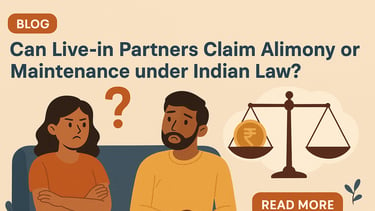Can Live-in Partners Claim Alimony or Maintenance under Indian Law?
This article provides an in-depth analysis of the legal rights of live-in partners in India, with a particular emphasis on their eligibility to seek alimony or maintenance.
FAMILY LAW
Deepika
7/23/20253 min read


With the increasing frequency of live-in relationships in India, the judiciary has had to address the legal implications of such relationships. This article analyses the legal aspects, judicial implications, and the provisions that apply in live-in relationships, highlighting the complexities involved in claiming maintenance or alimony. It provides insights into the rights and obligations of live-in partners and the major considerations that courts consider when figuring out maintenance claims. Live-in relationships have become increasingly common in India, and with this shift, questions about the legal rights and obligations of each in relation have gained significance. Indian law recognises the live-in partner rights through personal laws and statutes like the Hindu Marriage Act, 1955, and the Bharatiya Nagarik Suraksha Sanhita 2023 (Section 144).
Legal Framework:
The Indian legal system forms various statutes that govern live-in relationships, including marriage, divorce, and maintenance through the Hindu Marriage Act, 1955, and the Special Marriage Act, 1954, which provides the maintenance rights. Bharatiya Nagarik Suraksha Sanhita 2023 (Section 144). On the various groups of the provision, if he fails to provide for her, then the woman can claim maintenance in accordance with the act provisions.
Section 144(1) in Bharatiya Nagarik Suraksha Sanhita, 2023
If a person with enough money does not provide support for the following family members, a first-class magistrate can order them to pay monthly maintenance:
(a) Their wife if she cannot support herself.
(b) Their legitimate or illegitimate child, whether married or not, if the child cannot support themselves.
(c) Their legitimate or illegitimate child (not a married daughter) who is over 18 and unable to support themselves due to a physical or mental condition.
(d) Their father or mother if they cannot support themselves.
The magistrate will decide on a reasonable monthly amount to be paid to the person in need.
If the child in (b) is a girl, the magistrate can also require the father to provide support until she turns 18, if the husband (if married) cannot support her.
While the case for monthly support is ongoing, the magistrate can grant temporary maintenance for the wife or child, father, or mother, along with covering reasonable costs associated with the case.
The magistrate aims to resolve applications for this temporary support within sixty days of notifying the person involved.
Note: For this chapter, "wife" also includes a woman who has divorced her husband and has not remarried.
Judicial Precedents:
The judiciary has played a significant role in shaping the legal system. In the landmark case of Badri Prasad vs. Dy. In Director of Consolidation (1978), the Supreme Court recognized a live-in relationship as a valid relationship after a prolonged period of cohabitation. Later, in the case of Velusamy vs. D. Patchaiammal (2010), the Supreme Court laid down conditions for a live-in relationship to be considered akin to marriage, including cohabitation, financial dependence, and a relationship like marriage.
Domestic Violence Act, 2005:
The Protection of Women from Domestic Violence Act, 2005, safeguards women in live-in relationships, granting them the right to claim maintenance. The Act uses a broad definition of "domestic relationship," which includes both marriage and live-in relationships. This legislation has been crucial in recognising the rights of women in such arrangements.
Key definitions from the Act include:
(e) "Domestic incident report" refers to a report created in the prescribed format upon receiving a complaint of domestic violence from an aggrieved person.
(f) "Domestic relationship” means a relationship between two persons living together and sharing a household or at any point in time through consanguinity or marriage, adoption, or in a joint family.
(g) "Domestic violence" is defined in the same manner as outlined in Section 3 of the Act.
Claiming Maintenance:
To claim maintenance, both the partners should prove the case with their respective rights and the grounds for living in a relationship. The court heard both parties and will consider several factors, including the length of the relationship, the nature of the relationship, and the financial circumstances of both partners.
In conclusion, the rights of live-in partners to claim alimony or maintenance under Indian law depend upon several factors, including their rights, rules, and grounds with the provisions. To claim maintenance or alimony from the partner allows the woman secular provision of the Bharatiya Nagarik Suraksha Sanhita 2023 depending upon case facts and issues. It is essential for live-in partners to understand their rights and obligations and for the courts to continue evolving their approach to address the complexities of such relationships.
